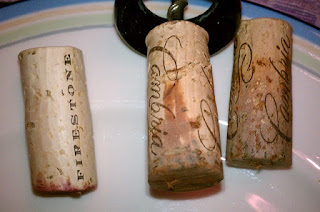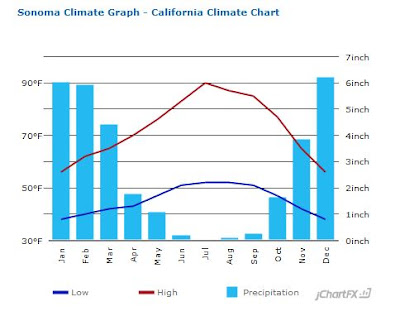Ordering the Wine
Let’s say that you have decided, for whatever reason,
that you are planning to go out for dinner and that you intend to order wine.
It’s a good idea to choose a wine (or more than one wine) before you arrive at
the restaurant so you are assured of getting what you wanted. If the restaurant
does not have an online wine list, ask it to email the list to you. Note that
it’s important that the wine list have the vintages listed, not just the labels
so you can do some research.
When you arrive at the restaurant you can also ask,
"Do you have a captain's list?" Very few restaurants have such
"limited selection" lists any more, but it indicates your willingness
to consider really expensive wines. Be aware that if the restaurant does have a
captain’s list, you may have just gotten yourself into a situation in which you
are going to spend more than you anticipated.
Once you have ordered the wine, a well-known series of
steps will begin. First, the waiter will present the bottle to you with the
label facing you. Rarely will a waiter bring you something you have not
ordered, but if that happens try, as nicely as possible, to inform him or her
that a mistake has been made. If the vintage does not match that on the wine
list, inform the waiter of that issue as well.
If the waiter informs you that the restaurant does not
have what you ordered but has something equally as good at a slightly higher
price, you can agree to order it but insist that you pay only what you would
have paid for the wine you ordered. Restaurants are gouging you pricewise
anyway so there is no reason for you to pay for their error.
The Ritual
Inspect the Cork
Assuming that the wine you ordered is the wine you
receive, the waiter will then remove the cork and place it in front of you. The
cork is presented for two reasons; first, the printing on the cork should match
the bottle. The second and more useful reason is for you to inspect the cork.
In rare instances, a wine may be so corky that the cork itself will have an
unpleasant odor. On even rarer occasions, the cork might be wet and shriveled
or dry and crumbly; either situation suggests that air has gotten into the wine
and spoiled it. If the cork raises your suspicions, let the waiter know but wait
to smell or taste the wine itself before deciding whether to reject the bottle.
Below are a couple of pictures of corks, both good and
bad.
If your cork breaks apart when the server takes it out
of the bottle, it does not mean that the wine will be bad. It does mean,
however, that the cork has dried out and the wine is probably bad. Sometimes
wine can be salvaged by decanting it but you are in a restaurant and don’t want
to wait around. I would reject the bottle in this instance. By the way a cork
can break if the server is clumsy or if the wine opener is too dull, so you
might want to keep that in mind.
In this picture the cork on the left is as it should
look after opening. On right are two corks showing the wine’s exposure to heat
and air. The corks on the right were from a Chardonnay bottle (thus the light
color.) When wine runs up the sides the bottle has not been stored correctly,
so once again this is an indication that the wine might be bad. If it goes more
than, I would say, one-eighth of the way up the cork, that’s a telltale sign
that something has happened to heat this wine up. Make a note of the cork to
the server and proceed to sniff the wine. If a cork looks suspicious, you can
also handle it. If a cork is bone dry, flaking and disintegrating that means that
the wine was probably not stored properly.
By the way, some people assume you’re supposed to sniff the
cork, a myth that has floated around the wine snob world for decades. The truth
is that you don’t actually learn all that much about a wine from smelling the
cork unless it has turned to vinegar.
Here is a little trivia--being presented with the cork
actually comes from the history of French wine in Bordeaux. Since Bordeaux is
one of the most expensive regions of wine in the world, people used to
counterfeit the bottles. When winemakers started to lose money to the
counterfeiters, they came up with the solution of creating unique inscriptions
on the corks inside the bottles, thus the inspection.
Synthetic corks, by the way, almost never fail, not do
screw caps.
Examine the Wine
Make sure the wine in the glass is the color it supposed
to be—it’s that easy. If it looks brownish, that’s not a good sign. Then swirl
the wine in the glass. Since most of the enjoyment of wine comes primarily from
aromas, swirling the wine will aerate it slightly, potentially releasing more
of those aromas. These will rest in the bowl of the glass as you raise it to
your nose.
By the way there is a notion that swirling wine in a
glass shows you its “legs” or “tears” which are supposed to indicate the
quality of the wine. This is not the case. The way the legs fall usually has to do with the level of alcohol in the wine and the speed at which it
evaporates, which means, in easier terms, that thicker and slower legs can indicate a higher alcohol
level.
“Sniff” the Wine
The next step of the ritual is when waiter pours a small
amount of wine into your glass and waits. Before you do anything, hold the
glass up and inspect the wine. If you notice bits of cork floating around, an
unlikely situation, reject the wine immediately. If the wine looks okay then
swirl the wine in the glass, take a sniff, perhaps a little sip, and then indicate
whether you find the wine acceptable. Swirling the wine gets oxygen into the
wine and allows the aroma to rise out of the glass. It is more effective with
red wines than with white wines. The aroma of the wine will also tell you if
something is wrong with it. If you decide wine is fine, you can nod or murmur,
“It’s fine.” If something is wrong with the wine, now is
the time to return it — not after you’ve finished half the bottle.
Here are some indicators that your wine has gone bad.
The wine is “corked.” The term
“corked” refers to what happens when a substance known as TCA is produced when
chlorine solutions used to sterilize corks contact mold in the cork. Corked
wine has a characteristic odor, variously described as resembling a moldy
newspaper, wet dog, damp cloth, or damp basement. If you sense these odors,
inform the waiter and send the wine back.
The wine is “cooked.” The term
“cooked” simply refers to a wine that has been overheated. Some people suggest
that a cooked wine tastes a bit like prunes or raisins. A dead giveaway of a
cooked wine, though, is if it is “fizzy.” Sometimes, a wine literally starts
fermenting again in the bottle, leaving the wine fizzy and off-flavored. This
happens when there are yeast and sugar still in the bottle and the temperature
gets too high, allowing the yeast to do what it wants to do. If you order
something other than champagne and it is fizzy, send it back.
Taste the Wine
If everything has gone well to this point, taste the
wine. You may be able to see if a wine has been cooked by seeing little bubbles
in the glass, but more than likely you will sense the fizz on your tongue.
Fizziness can be corrected by decanting but, once again, you are not obliged to
wait around for the problem to be resolved.
Handling the Wine at your Table
Let’s assume that you have ordered a chardonnay. After
the waiter pours some wine into each glass at the table, he might offer to
place the bottle into an ice bucket. You don’t want to do this. Drinking over
chilled white wine —good
white wine—deprives
one of fully enjoying the complex aromas and delicious flavors in the glass.
Basic science makes clear that raising the temperature at which a wine is
served allows the various flavor compounds in a wine to evaporate and rise,
thus adding to a wine’s aroma, which contributes greatly to enjoyment on the
palate. Unfortunately restaurant white wine it may well come to the table
straight from the refrigerator. If it feels too cold, let it sit a bit. How
long is that bottle going to last, anyway?
Summary
If you are going to order wine in a restaurant you are
going to pay a premium for it. It is your responsibility to make sure that you
are pleased with you purchase. If you send a wine back be prepared to explain
exactly why you are doing so.
About the picture
Chambré is used, in both French and English, to describe
a wine warmed to ambient (room - chamber) temperature. More precisely it refers
to a temperature of about 65 degrees F.








